

Survival of Trees. In this video a scientist explains how DNA extracted from ancient tree remains provides insights about how trees/plants have adapted, over time, to changes in CO2 in the atmosphere.
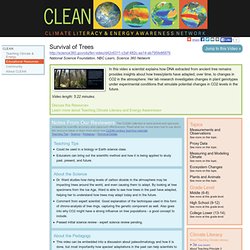
Her lab research investigates changes in plant genotypes under experimental conditions that simulate potential changes in CO2 levels in the future. Video length: 5:22 minutes. Science for a Hungry World: Agriculture and Climate Change. This NASA video explores the relationship between climate and agriculture, including the variability of climate change impacts that may occur in different regions and the effects of population growth and higher demands for food in areas that already struggle to supply food for the people.

The video highlights the need for accurate, continuous, and accessible data and computer models from NASA satellites to track and predict the challenges farmers face as they adjust to a changing climate. Video length: 5 min. Discuss this Resource»Learn more about Teaching Climate Literacy and Energy Awareness» Climate LiteracyAbout Teaching Climate Literacy Reducing human vulnerability to the impacts of climate change depends not only upon our ability to understand climate science, but also upon our ability to integrate that knowledge into human society. Seeking a green neighbourhood. Changes in Our Local Environment. Developed for Alaska Native students, this activity can be customized for other regions.

Blooming Thermometers. In this activity, students develop an understanding of the relationship between natural phenomena, weather, and climate change: the study known as phenology.

In addition, they learn how cultural events are tied to the timing of seasonal events. Students brainstorm annual natural phenomena that are tied to seasonal weather changes. Next, they receive information regarding the Japanese springtime festival of Hanami, celebrating the appearance of cherry blossoms. Now You See Ice, Now You Don't: Penguin Communities Shift on the Antarctic Peninsula. Climate LiteracyAbout Teaching Climate Literacy Ecosystems on land and in the ocean have been and will continue to be disturbed by climate change.
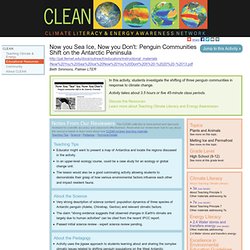
Animals, plants, bacteria, and viruses will migrate to new areas with favorable climate conditions. Infectious diseases and certain species will be able to invade areas that they did not previously inhabit. About Teaching Principle 7 Other materials addressing 7e Energy Literacy Excellence in Environmental Education Guidelines Benchmarks for Science LiteracyLearn more about the Benchmarks The world contains a wide diversity of physical conditions, which creates a wide variety of environments: freshwater, marine, forest, desert, grassland, mountain, and others.
Using Data to Predict Bleaching Events. In this EarthLabs activity, learners explore the concepts of coral bleaching, bleaching hot spots and degree-heating weeks.
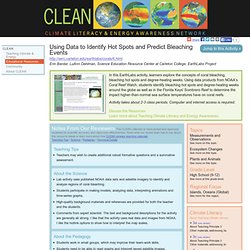
Using data products from NOAA's Coral Reef Watch, students identify bleaching hot spots and degree-heating weeks around the globe as well as in the Florida Keys' Sombrero Reef to determine the impact higher-than-normal sea surface temperatures have on coral reefs. Activity takes about 2-3 class periods. Computer and internet access is required. Climate Change and Citizen Science. Climate LiteracyAbout Teaching Climate Literacy Environmental observations are the foundation for understanding the climate system.
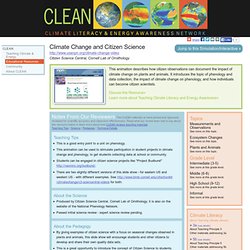
From the bottom of the ocean to the surface of the Sun, instruments on weather stations, buoys, satellites, and other platforms collect climate data. To learn about past climates, scientists use natural records, such as tree rings, ice cores, and sedimentary layers. Historical observations, such as native knowledge and personal journals, also document past climate change. About Teaching Principle 5 Other materials addressing 5b. Climate Change and Ecosystems. Notes From Our Reviewers The CLEAN collection is hand-picked and rigorously reviewed for scientific accuracy and classroom effectiveness.

Read what our review team had to say about this resource below or learn more about how CLEAN reviews teaching materialsTeaching Tips | Science | Pedagogy | Technical Details Teaching Tips Portions of this lesson can be used independently. Consider using a local ecosystem for research if relevant data and information are available. Consider taking a field trip to the study site before you begin the exercise/research project. Changing Planet: Withering Crops. This video examines what will happen to crops as Earth's temperature rises and soils dry out because of changing climate.
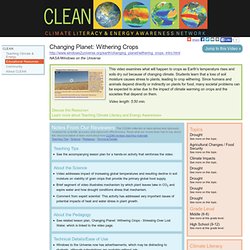
Students learn that a loss of soil moisture causes stress to plants, leading to crop withering. Changing Planet: Disappearing Lizards Classroom Activity. Changing Planet: Fading Corals Classroom Activity. Changing Planet: Changing Mosquito Genes Classroom Activity. Changing Planet: Adaptation of Species (Birds and Butterflies)
For background information on species adaptation, watch Changing Planet: Adaptation of Butterflies.
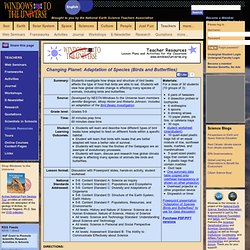
(This movie is linked on the first slide of the Powerpoint presentation). Also explore these topics on the Windows to the Universe website at the links listed below. Continue using the Powerpoint presentation "Adaptation of Species (Birds and Butterflies)" to facilitate class discussion. Show the images of different types of birds with different beak morphologies (slides 2-6) and ask students why they think the beaks are differently shaped. Lead students towards understanding that the beaks are specialized depending on the type of food that the birds eat. Assess student abilities to work together as a team, as well as apply learned information to make solid deductions about the future implications of global warming on species such as birds and butterflies. Use safe laboratory practices at all times. Have students help clean up their lab areas and properly store materials for future use.